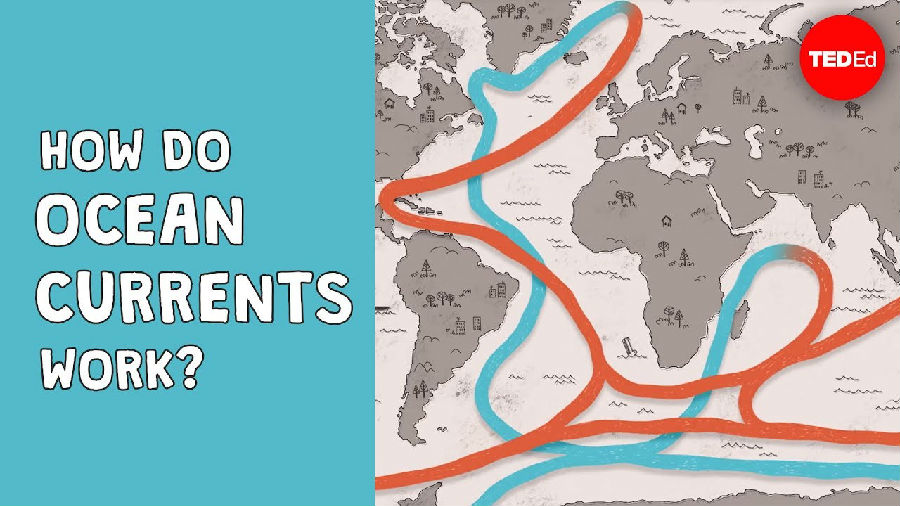(单词翻译:单击)
In 1992, a cargo ship carrying bath toys got caught in a storm.
1992年,一艘装载着洗浴玩具的货船遭遇了风暴。
Shipping containers washed overboard, and the waves swept 28,000 rubber ducks and other toys into the North Pacific.
货物被冲入海中,海浪将28000只橡胶鸭和其它玩具冲卷入北太平洋。
But they didn't stick together. Quite the opposite -- the ducks have since washed up all over the world,
但是它们没有集中在一起。恰恰相反--橡皮鸭被冲至世界各地,
and researchers have used their paths to chart a better understanding of ocean currents.
而研究者则利用它们的漂流轨迹绘制洋流图,以更好地了解它。
Ocean currents are driven by a range of sources: the wind, tides, changes in water density, and the rotation of the Earth.
洋流受到多个因素的驱使:风、潮汐、海水的密度变化和地球的自转。
The topography of the ocean floor and the shoreline modifies those motions, causing currents to speed up, slow down, or change direction.
洋底的地形和海岸线的形态影响着洋流的动态使它们或增速,或减速,或改变方向。
Ocean currents fall into two main categories: surface currents and deep ocean currents.
洋流分为两种:表层流和深海洋流。
Surface currents control the motion of the top 10 percent of the ocean's water, while deep-ocean currents mobilize the other 90 percent.
表层流控制着顶层10%的海水的动向,而深海洋流驱动着其它90%的海水。
Though they have different causes, surface and deep ocean currents influence each other in an intricate dance that keeps the entire ocean moving.
虽然这两种洋流的成因不同,但这两种洋流相互影响,以一种复杂的舞蹈保持海水的涌动。
Near the shore, surface currents are driven by both the wind and tides, which draw water back and forth as the water level falls and rises.
近岸处,风和潮汐推动着表层流,使得海水随着海水位的升降前进或后退。
Meanwhile, in the open ocean, wind is the major force behind surface currents.
同时,在开阔的洋面上,风是驱动表层流的主要力量。
As wind blows over the ocean, it drags the top layers of water along with it.
当风吹过洋面时,顶层的海水随它流动。
That moving water pulls on the layers underneath, and those pull on the ones beneath them.
流动的顶层海水带动了下层的海水,下层的海水又带动了更下一层的海水。
In fact, water as deep as 400 meters is still affected by the wind at the ocean's surface.
事实上,深至400米的海水仍受海水表面的风的影响。
If you zoom out to look at the patterns of surface currents all over the earth, you'll see that they form big loops called gyres,
如果你身处高空,观察世界各处洋流的流动模式,就会发现它们形成了被称为“流涡”的巨大回路,
which travel clockwise in the northern hemisphere and counter-clockwise in the southern hemisphere.
在北半球顺时针流动,而在南半球逆时针流动。
That's because of the way the Earth's rotation affects the wind patterns that give rise to these currents.
这是因为地球自转的方式影响着造就洋流的大气环流。
If the earth didn't rotate, air and water would simply move back and forth between low pressure at the equator and high pressure at the poles.
如果地球不自转,大气和海水就只会在赤道的低压带和两极的高压带之间来回移动。
But as the earth spins, air moving from the equator to the North Pole is deflected eastward, and air moving back down is deflected westward.
但实际上地球在自转,从赤道吹向北极的风向东偏转,而自北极向南吹的风向西偏转。

The mirror image happens in the southern hemisphere, so that the major streams of wind form loop-like patterns around the ocean basins.
南半球的情况则像是个镜像翻转,所以风的主流在海盆上形成了回路状的图案。
This is called the Coriolis Effect. The winds push the ocean beneath them into the same rotating gyres.
这就是所谓的“科里奥利效应”。流动的大气推动其下的海水形成了同样的流涡。
And because water holds onto heat more effectively than air, these currents help redistribute warmth around the globe.
因为水比大气更容易吸收热量,所以洋流促进了热量在全球范围内的流动。
Unlike surface currents, deep ocean currents are driven primarily by changes in the density of seawater.
与表层流不同,深海洋流的产生主要缘于海水密度的变化。
As water moves towards the North Pole, it gets colder.
当海水向北极流动时,水温逐渐降低。
It also has a higher concentration of salt, because the ice crystals that form trap water while leaving salt behind.
同时海水也有了更高的含盐量,因为冰晶使水凝固,而盐仍留在水中。
This cold, salty water is more dense, so it sinks,
这种冷且含盐度高的海水的密度越来越高,所以它向下沉,
and warmer surface water takes its place, setting up a vertical current called thermohaline circulation.
而温暖的表层流取代了它的位置,这便形成了被称作“热盐环流”的垂直洋流。
Thermohaline circulation of deep water and wind-driven surface currents combine to form a winding loop called the Global Conveyor Belt.
由深层海水和受风驱使的表层流构成的热盐循环构成了曲曲折折的回路--全球传送带。
As water moves from the depths of the ocean to the surface,
海水从洋底升至表层时,
it carries nutrients that nourish the microorganisms which form the base of many ocean food chains.
携带着滋养微生物的营养物质,而这些微生物正是许多海洋食物链的基础。
The global conveyor belt is the longest current in the world, snaking all around the globe.
全球传送带是世界上最长的洋流,蜿蜒环绕着整个地球。
But it only moves a few centimeters per second. It could take a drop of water a thousand years to make the full trip.
但它每秒只移动几厘米。对于一滴海水来说,做一次完整的旅行需要花上一千年。
However, rising sea temperatures are causing the conveyor belt to seemingly slow down.
然而,上升的海平面似乎使得传送带的速度慢了下来。
Models show this causing havoc with weather systems on both sides of the Atlantic,
相关模型显示,这正对大西洋两岸的天气系统造成严重破坏,
and no one knows what would happen if it continues to slow or if it stopped altogether.
而且人们无从得知,如果传导持续减慢,或干脆停下来的话,会有怎样的后果。
The only way we'll be able to forecast correctly and prepare accordingly
正确预测并做好相应防备的唯一方法,
will be to continue to study currents and the powerful forces that shape them.
是持续研究洋流和造就它们的巨大力量。


